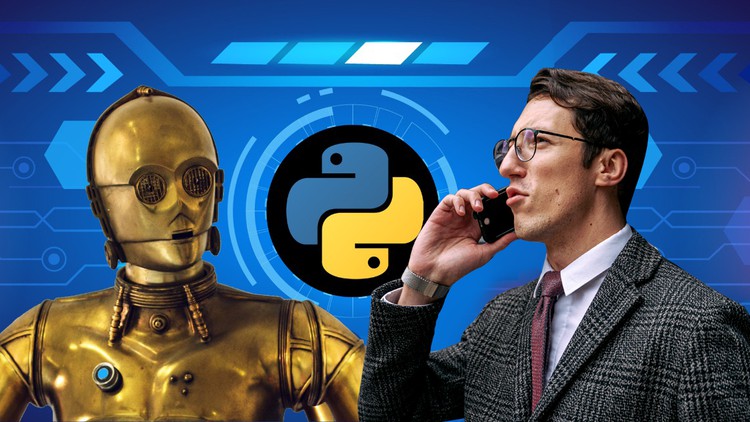This machine studying course will present you the basics of how firms like Google, Amazon, and even Udemy make the most of machine studying and synthetic intelligence (AI) to glean which means and insights from large information units. Glassdoor and Certainly each report that the typical wage for a knowledge scientist is $120,000. That is the usual, not the exception.
Knowledge scientists are already fairly fascinating. It’s troublesome to maintain them on workers in immediately’s tight labor market. There’s a extreme scarcity of people that possess the uncommon mixture of scientific coaching, laptop experience, and analytical skills.
At present’s information scientists are held to the identical requirements because the Wall Avenue “quants” of the ’80s and ’90s. When the necessity arose for modern algorithms and information approaches, physicists and mathematicians flocked to funding banks and hedge funds.
So, it’s no shock that information science is rising to prominence as a promising profession path within the modern-day. It’s analytic in focus, pushed by code, and carried out on a pc. Consequently, it shouldn’t be a shock that the demand for information scientists has been rising steadily within the office for the previous few years.
However, availability has been low. Acquiring the training and expertise essential to be employed as a knowledge scientist is hard. And that’s why we made this course within the first place!
Every matter is described in plain English, and the course does its greatest to keep away from mathematical notations and jargon. After getting entry to the supply code, you’ll be able to experiment with it and enhance upon it. Studying and making use of these algorithms in the true world, quite than in a theoretical or educational setting, is the main focus of this course.
Every video will depart you with a brand new perspective you could implement immediately!
When you’ve got no background in statistics, don’t let that cease you from enrolling on this course; we welcome college students of all ranges.
Introduction
Welcome to the Python for Knowledge Science & ML bootcamp!
Python: A Temporary Overview
The Python Set up Process
What Jupyter is?
Arrange Anaconda on Totally different Working Methods
How you can combine Python into Jupyter?
Dealing with Directories in Jupyter Pocket book
Enter & Output
Working with completely different datatypes
Variables
Arithmetic Operators
Comparability Operators
Logical Operators
Conditional statements
Loops
Sequences Half 1: Lists
Sequences Half 2: Dictionaries
Sequences Half 3: Tuples
Capabilities Half 1: Constructed-in Capabilities
Capabilities Half 2: Person-defined Capabilities
The Should-Have Python Knowledge Science Libraries
Finishing Library Setup
Library Importing
Pandas: A Knowledge Science Library
NumPy: A Knowledge Science Library
NumPy vs. Pandas
Matplotlib Library for Knowledge Science
Seaborn Library for Knowledge Science
NumPy Mastery: Every little thing you could find out about NumPy
Intro to NumPy arrays
Creating NumPy arrays
Indexing NumPy arrays
Array form
Iterating Over NumPy Arrays
Primary NumPy arrays: zeros()
Primary NumPy arrays: ones()
Primary NumPy arrays: full()
Including a scalar
Subtracting a scalar
Multiplying by a scalar
Dividing by a scalar
Increase to an influence
Transpose
Component-wise addition
Component-wise subtraction
Component-wise multiplication
Component-wise division
Matrix multiplication
Statistics
DataFrames and Sequence in Python’s Pandas
What’s a Python Pandas DataFrame?
What’s a Python Pandas Sequence?
DataFrame vs Sequence
Making a DataFrame utilizing lists
Making a DataFrame utilizing a dictionary
Loading CSV information into python
Altering the Index Column
Inplace
Analyzing the DataFrame: Head & Tail
Statistical abstract of the DataFrame
Slicing rows utilizing bracket operators
Indexing columns utilizing bracket operators
Boolean checklist
Filtering Rows
Filtering rows utilizing & and | operators
Filtering information utilizing loc()
Filtering information utilizing iloc()
Including and deleting rows and columns
Sorting Values
Exporting and saving pandas DataFrames
Concatenating DataFrames
groupby()
Knowledge Cleansing Strategies for Higher Knowledge
Introduction to Knowledge Cleansing
High quality of Knowledge
Examples of Anomalies
Median-based Anomaly Detection
Imply-based anomaly detection
Z-score-based Anomaly Detection
Interquartile Vary for Anomaly Detection
Coping with lacking values
Common Expressions
Characteristic Scaling
Exploratory Knowledge Evaluation in Python
Introduction
What’s Exploratory Knowledge Evaluation?
Univariate Evaluation
Univariate Evaluation: Steady Knowledge
Univariate Evaluation: Categorical Knowledge
Bivariate evaluation: Steady & Steady
Bivariate evaluation: Categorical & Categorical
Bivariate evaluation: Steady & Categorical
Detecting Outliers
Categorical Variable Transformation
Python for Time-Sequence Evaluation: A Primer
Introduction to Time Sequence
Getting inventory information utilizing yfinance
Changing a Dataset into Time Sequence
Working with Time Sequence
Time Sequence Knowledge Visualization with Python
Python for Knowledge Visualization: Library Assets, and Pattern Graphs
Introduction
Setting Up Matplotlib
Plotting Line Plots utilizing Matplotlib
Title, Labels & Legend
Plotting Histograms
Plotting Bar Charts
Plotting Pie Charts
Plotting Scatter Plots
Plotting Log Plots
Plotting Polar Plots
Dealing with Dates
Creating a number of subplots in a single determine
The Fundamentals of Machine Studying
Why do we’d like machine studying?
Machine Studying Use Circumstances
Approaches to Machine Studying
What’s Supervised studying?
What’s Unsupervised studying?
Supervised studying vs Unsupervised studying
Easy Linear Regression with Python
Introduction to regression
How Does Linear Regression Work?
Line illustration
Implementation in python: Importing libraries & datasets
Implementation in python: Distribution of the info
Implementation in python: Making a linear regression object
A number of Linear Regression with Python
Understanding A number of linear regression
Exploring the dataset
Encoding Categorical Knowledge
Splitting information into Practice and Check Units
Coaching the mannequin on the Coaching set
Predicting the Check Set outcomes
Evaluating the efficiency of the regression mannequin
Root Imply Squared Error in Python
Classification Algorithms: Ok-Nearest Neighbors
Introduction to classification
Ok-Nearest Neighbors algorithm
Instance of KNN
Ok-Nearest Neighbours (KNN) utilizing python
Importing required libraries
Importing the dataset
Splitting information into Practice and Check Units
Characteristic Scaling
Importing the KNN classifier
Outcomes prediction & Confusion matrix
Classification Algorithms: Resolution Tree
Introduction to choice timber
What’s Entropy?
Exploring the dataset
Resolution tree construction
Importing libraries & datasets
Encoding Categorical Knowledge
Splitting information into Practice and Check Units
Outcomes Prediction & Accuracy
Classification Algorithms: Logistic regression
Introduction
Implementation steps
Importing libraries & datasets
Splitting information into Practice and Check Units
Pre-processing
Coaching the mannequin
Outcomes prediction & Confusion matrix
Logistic Regression vs Linear Regression
Clustering
Introduction to clustering
Use circumstances
Ok-Means Clustering Algorithm
Elbow technique
Steps of the Elbow technique
Implementation in python
Hierarchical clustering
Density-based clustering
Implementation of k-means clustering in python
Importing the dataset
Visualizing the dataset
Defining the classifier
3D Visualization of the clusters
3D Visualization of the expected values
Variety of predicted clusters
Recommender System
Introduction
Collaborative Filtering in Recommender Methods
Content material-based Recommender System
Importing libraries & datasets
Merging datasets into one dataframe
Sorting by title and score
Histogram exhibiting variety of scores
Frequency distribution
Jointplot of the scores and variety of scores
Knowledge pre-processing
Sorting the most-rated motion pictures
Grabbing the scores for 2 motion pictures
Correlation between the most-rated motion pictures
Sorting the info by correlation
Filtering out motion pictures
Sorting values
Repeating the method for an additional film
The put up Python for Knowledge Science & Machine Studying: Zero to Hero appeared first on destinforeverything.com/cms.









